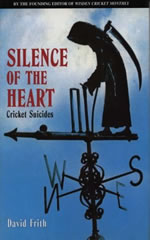Silence of The Heart
Stuart Wark |Published: 2001
Pages: 256
Author: Frith, David
Publisher: Mainstream Publishing
Rating: 4 stars

Many commentators have said that cricket is, when you break it down to its purest essences, just a game. This definition is certainly simplistic, and perhaps even a little sacrilegious for many, but ultimately it is true. Nonetheless, cricket is a subject that arouses great passions in people all around the world, and the results of either their team or their own performances can have a decided impact upon an individual’s state of mind. Cricket has also been called a team game played between individuals. Sadly, cricket has attracted many participants who have battled themselves and their own inner daemons as much as any opposition players. David Frith’s book, Silence of the Heart (originally published as ‘By His Own Hand’), is a look at the tragedy of those cricketing heroes who were unable to cope with the demands of an existence post-cricket, and who sadly chose to end their own life.
Suicide would appear to be a very strange topic for a cricketing book, and without reading Frith’s work, it certainly appears quite macabre on face value. However, Frith has managed to look at many cricketers who have killed themselves, and produced one of the most fascinating books on the sport. Cricket has a suicide rate that exceeds the national averages for the respective cricketing nations, and it is estimated that more than one hundred and fifty professional cricketers have chosen to end their own lives. The hallmark of all Frith’s books is impeccable research, however, in Silence of the Heart he also manages to write with great poignancy and respect for the individuals concerned.
It is possible to read the book from start to finish, but the subject matter almost encourages the reader to instead take a more measured approach and dip into it over a period of time. Frith has written the book as a mini-biography of selected players, which allows the reader to take the time to examine and evaluate each individual situation without becoming overwhelmed by underlying sadness that each case invokes.
Frith’s research records the famous to the almost unknown, from legends of the past such as Shrewsbury and Stoddart through to more recent cases such as David Bairstow. However, it does not, and could not, provide the answers to why. Whilst some of the suicides described could be understood in the light of financial pressure, marital breakup or depression, others remain a complete mystery. One of the most striking aspects of the book for me personally were the pictures; you can see the face each cricketer presented to the outside world, but their inner turmoil remains hidden. Looking at the many photos of smiling and seemingly happy cricketers affected me more than I would have thought. I look back now and I know what fate is to befall the person in the photo, but they appear ignorant of their future despair. I can’t help but wonder what more could have been done to help them.
This is ultimately a very sad and moving book, but one of great value to both cricket lovers and the wider community.






Leave a comment